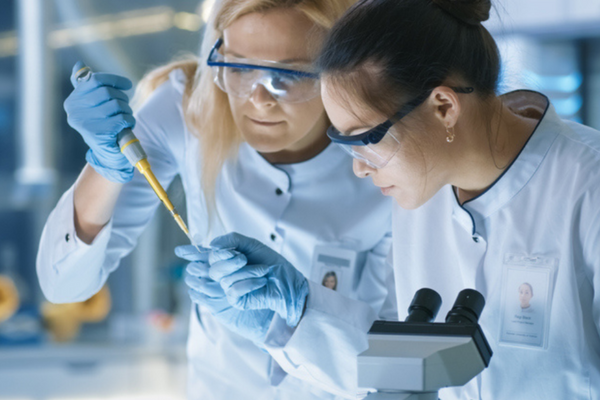
Key Takeaways:
- Chuck Crawford comments on the demand for hand sanitizer and what steps Purell plans on taking to meet the demand
- Recommendations on how to maximize the sanitization properties of Purell’s hand sanitizer
- When Crawford realized he wanted to study chemistry
In an article published on January 22, 2021, the Wall Street Journal reported that GOJO Industries, which manufactures PURELL® Hand Sanitizer, was investing in a new factory and warehouse on the expectation that demand for hand sanitizer will remain high even when the pandemic relents. Is the company banking more on institutional demand, or consumer demand, to remain high?
The answer is less of an “either/or” but truly an “and.” We believe the world will forever be changed by this pandemic, and we see this translating to a sustained increase in awareness and importance of safe and effective hygiene practices across all markets and product categories, including consumers, resulting in ongoing, heightened demand for our essential PURELL® skincare and surface solutions.
Pre-pandemic, hand and surface hygiene may have been viewed as “nice to have” in many settings. Now, in many situations, we expect it may be viewed as mandatory, either through expectation or policy. There is a clear role for the PURELL® brand to play in supporting facilities, restaurants, and other businesses – to help these businesses show they prioritize the health, safety, and well-being of their guests, customers, and employees.
As students return to their academic setting, the PURELL® brand can help schools create and maintain safe, healthy learning environments. There is significant data that shows that PURELL® products in any facility help eliminate germs that can cause illness and increases confidence and peace of mind for patrons, patients, and students. Combined with our longstanding position in healthcare, we believe the demand in institutional settings will remain.
In service of our GOJO Purpose, Saving Lives and Making Life Better through Well-Being Solutions, our responsibility to keep the world healthy and well has never been greater.
That same Wall Street Journal piece cited a partnership started last summer between your company and St. Albert the Great School, which is about 30 miles from your Akron, Ohio headquarters. GOJO outfitted the school with hand sanitizing stations at every doorway in exchange for insights from the school. What kind of insights were you after, and what did you learn?
The relationship with St. Albert the Great was initiated through a conversation with the school’s principal, Ed Vittardi. Initially, the school sought advice on how to reduce risks and to gain a better understanding of what they needed to do differently in the context of cleaning and hygiene. This included elements such as frequency, best practices, and placement of hand sanitizer dispensers.
GOJO was seeking a deeper understanding of how schools were interacting with state and local public health departments during the pandemic and how to get students back into schools safely – both in the context of infection prevention/control and product exposure. I believe our learnings are well summarized in the Wall Street Journal article, which includes a quote from Principal Vittardi.
"The school, with 935 students, had five absences in the week before Christmas, compared with 40 to 50 absences on a given day in December before the pandemic, said Ed Vittardi, the school’s principal. He said when the pandemic abates, the school would likely scale back some cleaning, such as spraying down meeting rooms with disinfectant after every use. But he intends to keep hand-sanitizing stations and separate health clinics."
In a blog post you authored on July 28, 2020, you began the piece with the following: “This pandemic has transformed how we think about hand hygiene – both our handwashing and hand sanitizing practices.” If you are right, what are the implications for the future of public health in the U.S.? For example, all things being equal, would you expect to see fewer cases of the flu?
The FDA, CDC, and other public health thought leaders acknowledge the significant role of hand and surface hygiene in protecting public health and safety. And I anticipate that most of us are experiencing the enhanced role that hygiene is now playing in our minds and daily lives. With greater attention being paid to these categories and good, consistent practices more firmly entrenched in the minds of the general public, we can anticipate this to have an overall positive impact and a reduction in germ transmission. Embedding these habits and practices can only have a positive, correlative impact.
We also expect a continued step-change in penetration of hand hygiene opportunities, with hand sanitizer being a more standard offering in locations and situations that were previously neglected, such as entrances to office buildings, public transportation, and schools. This new presence can also be anticipated to have a positive impact and enhance public health and safety.
If users of PURELL® Hand Sanitizer want to maximize its sanitizing properties, how much should they dispense, and how long should they rub their hands with the product?
When applying PURELL® hand sanitizer, use one pump from the bottle – approximately the size of a quarter – enough to thoroughly wet your hands. Rub your hands together briskly until dry – making sure to cover all surfaces of your hands and fingers, including your fingertips, thumbs and in between your fingers. This should take around 15-20 seconds.
How do you anticipate your operations will change in the next normal, i.e, the post-pandemic period? And what skills will be necessary for your scientists to be successful in this environment?
In terms of operations, GOJO is reaching new heights. GOJO is investing $400 million during the pandemic, greatly expanding our capacity while producing and shipping 300% more PURELL® Hand Sanitizer than we did in 2019. We activated 2.5 million square feet of manufacturing space and pulled forward 10 years of capital spending for new lines and equipment. We’ve also welcomed over 500 new team members. From the evaluation of alternative raw materials to sourcing/qualifying new components to creating new, innovative solutions to serve the needs of the market, our GOJO scientists have worked closely with our cross-functional business partners every step of the way.
Those scientists that are highly collaborative, strong communicators, resilient, and bring a spirit of entrepreneurialism have opportunities to really grow and thrive in the future state. This, of course, assumes they bring the inherent technical acumen requisite to their roles.
But as I have experienced throughout my career, progress is rarely (if ever) accomplished individually, and those scientists that can bring their technical expertise to bear in broader settings and solve problems at all levels are uniquely positioned for long-term success. In the simplest of terms, those skills required to be successful in the next normal might be summarized as “listen, learn, apply, repeat.”
When did you realize you wanted to study chemistry, and what led to that realization?
There were a few influential moments that informed my interest in chemistry and ultimately lead to my pursuit of a career in the field. While I had always been interested in science as a kid, it was my high school chemistry class where I was first exposed to the idea (or maybe better phrased, I finally understood) that one could step into a laboratory and create something completely new to the world – something that nobody had seen before.
It was also one of the few subjects that felt less like learning what was already known and pushed to explore what could be. That informed my decision to study chemistry as I entered college. Then, as an undergraduate at the College of Wooster I got my first exposure to conducting independent research. The excitement of scientific inquiry I experienced there reinforced my passion for the subject and prompted my decision to continue studying chemistry at the graduate level.
Some executives in your position combine a degree in chemistry or chemical engineering with an MBA. Others, like you, supplement their chemistry undergrad degree with a PhD in chemistry. How would you assess the pros and cons of each approach?
That’s a really tough question, as I truly perceive the pros and cons of each approach to be highly personal and individualized. In all cases, the pursuit of an advanced degree is a significant investment in oneself – an investment of effort, resources, time, etc. And many will use terms like “sacrifice” in this context. However, when I have the chance to coach or mentor professionals with interest in the pursuit of additional fields of study, I challenge them to contemplate the impact of the journey itself as much, if not more so, than the outcome.
Pursuing an advanced degree in nearly any field requires passion and commitment to really extract the intended value and personal growth. Absent that, it has the potential create a painful, frustrating experience – and, of course, no ends are guaranteed. So, my recommendation? Look for opportunities to gain new experiences, take on stretch assignments, and seek guidance to help inform those areas that ignite your passion. This can help create the opportunity for self-reflection, broadening an individual’s experiences and opening the aperture of what is possible or desired.
It almost inverts the discussion from “what do I have to do to get there?” to “this is what I really want to do, what opportunities do I create for myself along the way?” I also like this mindset as it creates an element of empowerment over an individual’s development and career path.
Personally, I have been fortunate to have a strong network of support, both academically and professionally, that helped mold my path and helped me prepare for the next step – rarely was that next step pre-defined beyond the journey itself.
How have your parents influenced your leadership style?
We lost my mother when I was quite young, and it would probably come as no surprise that watching my father raise his family as a single parent was one of the most powerful influences in my life. It wasn’t only his commitment to me and my siblings, but also how he did it – instilling in all of us high expectations for ourselves, a powerful work ethic, a mindset to overcome challenges, and an equally strong element of respect and empathy for others. These are pretty solid foundations for leadership, and I try to reflect them in my own leadership style to this day.
How has the innovation process within GOJO changed since the pandemic hit?
I think it is very fair to say that the innovation process within GOJO was well tested by the pandemic – and I am pleased to say that it appears to have served the enterprise quite well! The sheer number of initiatives and volume of effort flowing through the process to serve the surging needs of the market and public were unprecedented. There were (and still remain) ever-present demands for speed, agility, and resilience.
And while the existing process served us well, the experience reinforced the power of our purpose-driven culture in empowering leaders at all levels within the enterprise to make decisions, engage their cross-functional partners, leverage their entrepreneurial spirit, and take action. The pandemic also reinforced the company’s philosophy of innovative partnerships and “innovation without walls” – humbly leveraging partnerships (and forging new ones) to deliver.
And while the process and culture served the enterprise well, there remains a tremendous amount of learning for us to take forward. This has also been an enduring characteristic of GOJO, the willingness to learn, adapt and evolve. In fact, Always Learning is one of our core Values.
Based on your experience, what are some of the primary reasons innovations fail to achieve market success?
That’s a complex question, and there are volumes of information out there striving to pin this down! And while this might be perceived as a biased point of view, my experience is that failure is rarely the result of a technology or product not performing as intended.
Those innovation programs that are successful generally hit on a number of key elements – delivering value, delighting the customer/consumer, creating memorable experiences, solving an unmet need, and being executed with excellence. The absence of any one of these elements really creates the potential for an innovation to fall short of expectations.
With respect to your company scientists, what non-technical skills do you most highly value?
There are many, and this is also an area where a detailed answer can be quite individualized, leveraging the skills of our team members against the needs of the business. However, those non-technical skills that tend to be common denominators include collaboration, communication, and creativity. Further, the ability to connect technology to needs – to connect what is possible to what is needed – is a prized skillset. These are highly coveted skills in any organization, and I have found this to be particularly true here at GOJO.
If I want to work at GOJO, will it help my chances if I declare myself to be a germophobe?
Unfortunately, it probably will not – we embrace germophiles as much as we do germophobes! This absence of bias is driven by science and the fact that not all germs are bad germs. In fact, some intriguing areas of research include the fields of microbiomics and metabolomics and their potential application to public health and safety!

Chuck Crawford is Chief Innovation Officer at GOJO Industries, the makers of PURELL® products and a global leader in skin health and hygiene solutions, headquartered in Akron, Ohio. Chuck leads numerous functions across the R&D and Regulatory landscape for the enterprise, including front-end innovation, formulation sciences, product engineering (dispensing/delivery systems), regulatory affairs, product safety, and efforts focused on the advancement of public health.
Chuck and his teams work cross-functionally to commercialize innovative skin care and surface disinfection products/programs designed to deliver on the GOJO Purpose – Saving Lives and Making Life Better Through Well-Being Solutions.
Chuck is a native of northeast Ohio, growing up only a few miles from GOJO headquarters. He holds a B.A. in Chemistry from the College of Wooster (Wooster, OH) and received a PhD in inorganic chemistry from Indiana University (Bloomington, IN). His graduate school efforts focused on the design, synthesis, characterization, and reactivity of rhodium (II) carboylate complexes to inform their mechanism of activity as anti-tumor agents. Chuck concluded his academic career as an NIH Post-Doctoral Research Fellow at Harvard University (Cambridge, MA) under the direction of Professor Richard H. Holm where he continued to investigate biomimetic transition metal complexes, namely those of iron, molybdenum, and nickel.
After leaving academia, Chuck held numerous technical roles with organizations serving the consumer, industrial, and institutional markets, including Unilever Research, JohnsonDiversey, The Sun Products Corp., and Henkel North America, before joining GOJO last year. He has served on the Boards of Directors for the Cleaning Industry Research Institute (CIRI) and American Cleaning Institute (ACI).
This article has been edited for length and clarity. The opinions expressed in this article are the author's own and do not necessarily reflect the view of their employer or the American Chemical Society.
Copyright 2022 American Chemical Society (All Rights Reserved)











